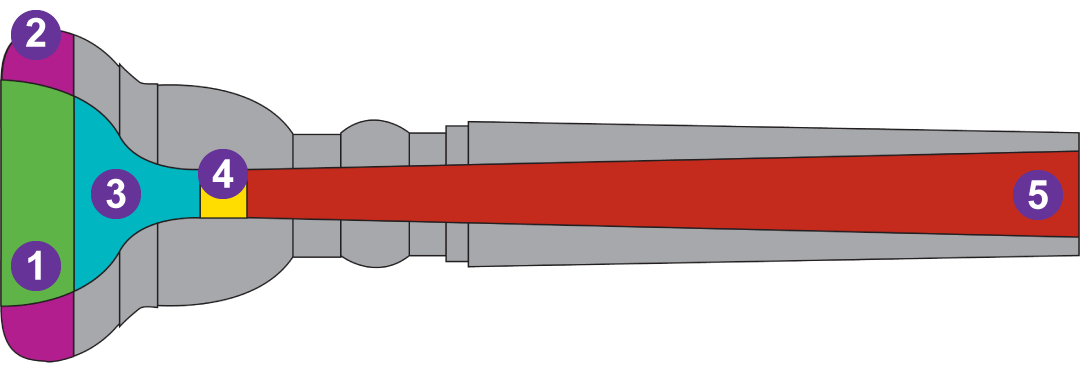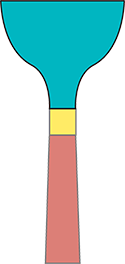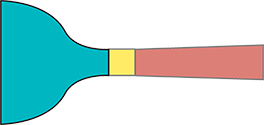Trumpet Mouthpiece Basics
It can be helpful to think of trumpet mouthpieces like shoes in the sense that there are two aspects to consider when choosing them: fit and function.
With that in mind, these are some key characteristics to keep in mind.


1. Cup Diameter
As the inside cup diameter of the mouthpiece increases, the player will have an easier time producing a bigger, broader, richer sound. However, if the diameter is too big for the player, this comes at the expense of high range and endurance. The goal is to find a mouthpiece that helps the player produce their desired sound while also maintaining a good fit in the diameter of the mouthpiece cup.
Manufacturers approach mouthpiece sizing nomenclature differently, so comparison charts can be helpful when comparing mouthpieces of different manufacturers.

3. Cup Depth & Shape
Cup Depth
Once the player has arrived at a good fit in mouthpiece cup diameter, the inside cup depth is the next variable to consider. A medium cup depth is good for most players, as it is designed to function well in a variety of genres and styles. Shallower cups provide more ease in the upper register, and also increase the brightness of the sound, while deeper cups help produce a richer, more symphonic sound, but don’t help as much in the upper register.
Comparison charts are helpful here as well, as manufacturers notate mouthpiece cup depths differently.
Cup Shape
Cup shape can tend to be a more subjective variable. Most all-around mouthpieces are designed with a bowl-shaped cup, but some players find that some amount of a V shape in the cup gets them closer to their desired sound. Shallow V-shaped cups can be a good choice for commercial playing, but at the same time some commercial players will still prefer a shallow bowl shape. A deeper cup with a slight V may also be a good symphonic mouthpiece, depending on the player.
Weight / Mass
The physical weight or mass of a mouthpiece is also a variable to consider when choosing a mouthpiece. Lighter-weight mouthpieces tend to make it easier to produce a brighter sound, while heavier mouthpieces can aid in projection. Keep in mind that a heavier mouthpiece does not necessarily mean it will produce a darker sound, though this is also a possibility.

2. Rim Contour
Rim contour can also affect how the mouthpiece feels to play. Some players prefer a mouthpiece with more bite on the inner rim to maintain a grip on the mouthpiece, while others prefer a mouthpiece with a flatter rim and less bite for more cushion. A flatter rim can be more popular for commercial playing applications as it can aid in endurance for some players.

4. Throat Size
The throat of a mouthpiece is the tightest point of the mouthpiece and is commonly measured by drill bit size. For instance, a #27 throat corresponds to a #27 drill bit. This is a standard throat size, and as the number decreases, the throat size increases.
A larger throat generally means that the mouthpiece will require more air because the volume of the mouthpiece has increased. If a standard mouthpiece feels tight or restrictive to play, a version with a bigger throat may feel more open-playing. As with mouthpiece cup diameter, it is important to find a mouthpiece throat size that helps produce the player’s desired sound, while not feeling too big.
5. Backbore Size
The backbore of a mouthpiece describes the taper of the inside of the mouthpiece from the throat to the end of the shank. Mouthpiece backbores can be difficult to quantify, as sometimes there are manufacturer trade secrets involved, and backbores can be difficult to visualize by looking at the mouthpiece.
Manufacturers will sometimes describe backbores as being more open or tight, often to match a more open or tight throat. Some manufacturers will also describe how the backbore tapers, and may even have a visual aid, but there is no set rule on what kind of a taper will work for any given trumpet player.
Try them out!
A common theme in this discussion is that often there is no set rule on how a certain mouthpiece specification will affect the feel and sound of a mouthpiece. In order to know what works for you, try several mouthpieces. Find an expert to guide you and help you narrow down the choices to the options that work best for your needs, and you’ll be on your way to a more efficient set-up!

1. Cup Diameter
As the inside cup diameter of the mouthpiece increases, the player will have an easier time producing a bigger, broader, richer sound. However, if the diameter is too big for the player, this comes at the expense of high range and endurance. The goal is to find a mouthpiece that helps the player produce their desired sound while also maintaining a good fit in the diameter of the mouthpiece cup.
Manufacturers approach mouthpiece sizing nomenclature differently, so comparison charts can be helpful when comparing mouthpieces of different manufacturers.

2. Rim Contour
Rim contour can also affect how the mouthpiece feels to play. Some players prefer a mouthpiece with more bite on the inner rim to maintain a grip on the mouthpiece, while others prefer a mouthpiece with a flatter rim and less bite for more cushion. A flatter rim can be more popular for commercial playing applications as it can aid in endurance for some players.

3. Cup Depth & Shape
Cup Depth
Once the player has arrived at a good fit in mouthpiece cup diameter, the inside cup depth is the next variable to consider. A medium cup depth is good for most players, as it is designed to function well in a variety of genres and styles. Shallower cups provide more ease in the upper register, and also increase the brightness of the sound, while deeper cups help produce a richer, more symphonic sound, but don’t help as much in the upper register.
Comparison charts are helpful here as well, as manufacturers notate mouthpiece cup depths differently.
Cup Shape
Cup shape can tend to be a more subjective variable. Most all-around mouthpieces are designed with a bowl-shaped cup, but some players find that some amount of a V shape in the cup gets them closer to their desired sound. Shallow V-shaped cups can be a good choice for commercial playing, but at the same time some commercial players will still prefer a shallow bowl shape. A deeper cup with a slight V may also be a good symphonic mouthpiece, depending on the player.

4. Throat Size
The throat of a mouthpiece is the tightest point of the mouthpiece and is commonly measured by drill bit size. For instance, a #27 throat corresponds to a #27 drill bit. This is a standard throat size, and as the number decreases, the throat size increases.
A larger throat generally means that the mouthpiece will require more air because the volume of the mouthpiece has increased. If a standard mouthpiece feels tight or restrictive to play, a version with a bigger throat may feel more open-playing. As with mouthpiece cup diameter, it is important to find a mouthpiece throat size that helps produce the player’s desired sound, while not feeling too big.
5. Backbore Size
The backbore of a mouthpiece describes the taper of the inside of the mouthpiece from the throat to the end of the shank. Mouthpiece backbores can be difficult to quantify, as sometimes there are manufacturer trade secrets involved, and backbores can be difficult to visualize by looking at the mouthpiece.
Manufacturers will sometimes describe backbores as being more open or tight, often to match a more open or tight throat. Some manufacturers will also describe how the backbore tapers, and may even have a visual aid, but there is no set rule on what kind of a taper will work for any given trumpet player.
Weight / Mass
The physical weight or mass of a mouthpiece is also a variable to consider when choosing a mouthpiece. Lighter-weight mouthpieces tend to make it easier to produce a brighter sound, while heavier mouthpieces can aid in projection. Keep in mind that a heavier mouthpiece does not necessarily mean it will produce a darker sound, though this is also a possibility.
Try them out!
A common theme in this discussion is that often there is no set rule on how a certain mouthpiece specification will affect the feel and sound of a mouthpiece. In order to know what works for you, try several mouthpieces. Find an expert to guide you and help you narrow down the choices to the options that work best for your needs, and you’ll be on your way to a more efficient set-up!

